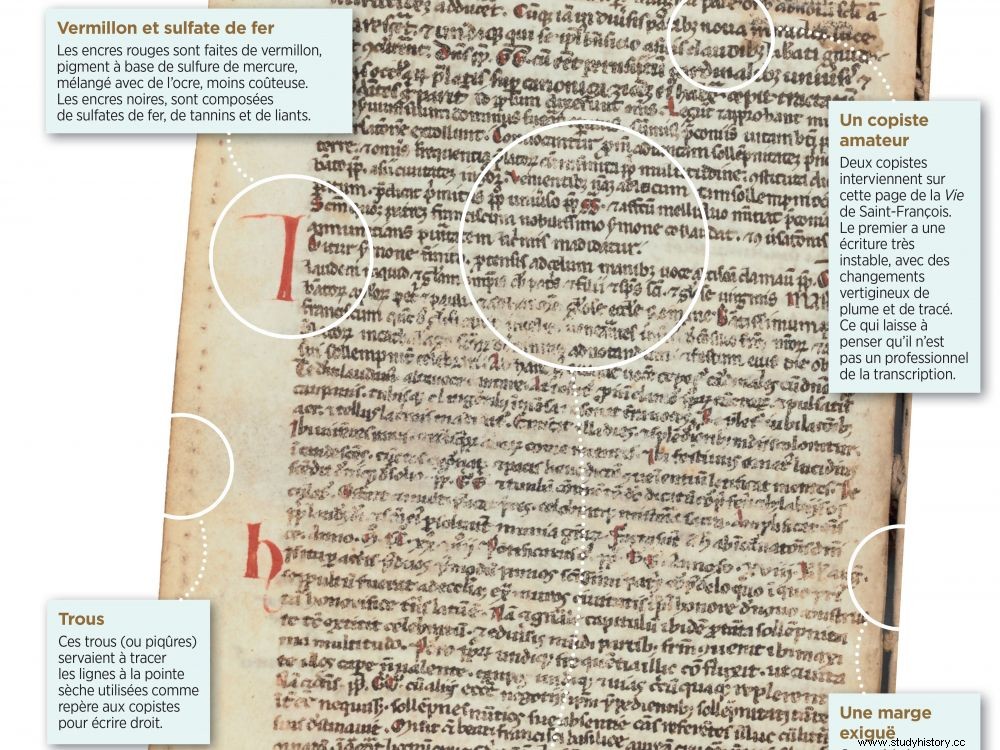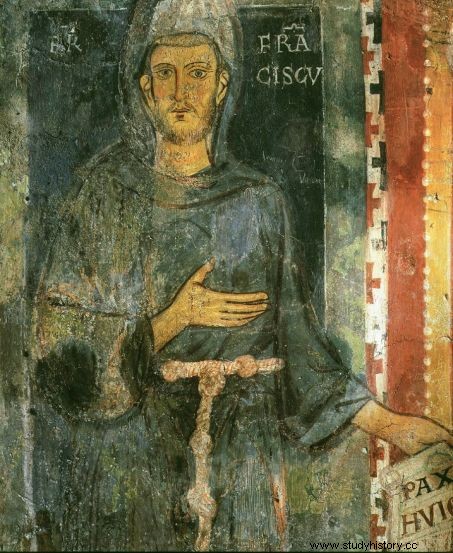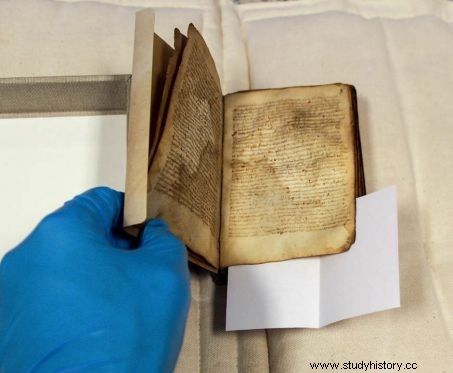Six years were needed by an international group of researchers to analyze this exceptional 13th century manuscript containing an unpublished account of the life of Saint Francis of Assisi written just a few years after his death.

Six years were necessary for an international group of researchers to analyze this exceptional manuscript.
This article is from the magazine Sciences et Avenir - La Recherche n°895 dated September 2021.
It all starts with an email. September 2014, the French historian Jacques Dalarun, specialist in Saint Francis of Assisi (1181-1226) and his religious doctrine, Franciscanism, receives a message from his American colleague, Sean Field. "It contains a link to the website of American dealers in ancient manuscripts, the gallery Les Enluminures , recalls Jacques Dalarun. Director Sandra Hindman, a University of Chicago codicologist, puts a manuscript up for sale; this is accompanied by a very good description written by an excellent scholar, Laura Light." A passage in the notice challenges the historian:"Laura Light wonders if the manuscript does not contain an exceptional text:a Life , that is to say a biography, unknown, of Saint Francis of Assisi, written in the years following his death. "Being one of the oldest accounts of Francis's existence, among dozens written in medieval times, and while these early texts are believed to have been destroyed following a 1266 decree imposing a new version official account of the life of the Italian saint (that of Saint Bonaventure, dating from 1263).
The first hagiographer of Saint Francis
Neither one nor two, the specialist embarks on reading the prologue of this text available on the gallery's website. "From the first lines, confirmation falls. The author is Thomas of Celano, first hagiographer of Saint Francis, and he writes to Brother Elijah, one of the first successors of the founder at the head of the Franciscan order, the Friars Minor (1232-1239), in these terms:'You are general minister and, on your order, I write this short story Life of François, which is the abridged version of my previous Life', explains Jacques Dalarun. Can you imagine my happiness!" The historian immediately translates the text from Latin into French. His work meets a lot of echo.
This article is from the magazine Sciences et Avenir - La Recherche n°895 dated September 2021.
It all starts with an email. September 2014, the French historian Jacques Dalarun, specialist in Saint Francis of Assisi (1181-1226) and his religious doctrine, Franciscanism, receives a message from his American colleague, Sean Field. "It contains a link to the website of American dealers in ancient manuscripts, the gallery Les Enluminures , recalls Jacques Dalarun. Director Sandra Hindman, a University of Chicago codicologist, puts a manuscript up for sale; this is accompanied by a very good description written by an excellent scholar, Laura Light." A passage in the notice challenges the historian:"Laura Light wonders if the manuscript does not contain an exceptional text:a Life , that is to say a biography, unknown, of Saint Francis of Assisi, written in the years following his death. "Being one of the oldest accounts of Francis's existence, among dozens written in medieval times, and while these early texts are believed to have been destroyed following a 1266 decree imposing a new version official account of the life of the Italian saint (that of Saint Bonaventure, dating from 1263).
CODICOLOGIST: Specialist who studies the materials used to make ancient manuscripts.
SHEET: It corresponds to half of a sheet of paper or parchment folded on itself (what is called a bifolium).
CODEX: It is a manuscript book made up of sheets folded in half and assembled in one or more notebooks sewn with a thread along the fold.
The first hagiographer of Saint Francis
Neither one nor two, the specialist embarks on reading the prologue of this text available on the gallery's website. "From the first lines, confirmation falls. The author is Thomas of Celano, first hagiographer of Saint Francis, and he writes to Brother Elijah, one of the first successors of the founder at the head of the Franciscan order, the Friars Minor (1232-1239), in these terms:'You are general minister and, on your order, I write this short story Life of François, which is the abridged version of my previous Life', explains Jacques Dalarun. Can you imagine my happiness!" The historian immediately translates the text from Latin into French. His work meets a lot of echo. And for good reason:it had been more than a hundred years since we had made a textual discovery of this magnitude on Saint Francis! But after going through the complete manuscript, Jacques Dalarun understands that his interest goes well beyond the text devoted to the life of the monk, which represents only one eighth of the document of 122 pages. "It was necessary to ensure that the manuscript remained freely accessible to all, says the historian. So I alerted Isabelle Le Masne de Chermont, director of the manuscripts department at the National Library of France." His plea hits the nail on the head. The BNF makes a purchase offer, which is accepted. The codex joined the collections of the prestigious library at the beginning of 2015. In the following months, it was digitized and made available to everyone on Gallica, the BNF's digital library.

122 leaves of a parchment made of "low pieces" of goatskin, sewn with a thread probably in linen, form the codex. Credit:BNF, PARIS
At the same time, the research work begins. Jacques Dalarun brings together around him people from his CNRS laboratory, the Institute for Research and History of Texts, the BNF. This "manuscript community", of about ten members, brings together physicists, chemists, paleographers (specialists in ancient writing), codicologists, etc. The idea is that everyone, in their area of specialization, brings their view of the document, crossing their fingers so that the analyzes complement and reinforce each other, and that we can, thanks to this collective work, replace the manuscript in its context. For nearly six years, during which other specialists from all over the world joined the adventure, the team looked at the book from every angle, transcribed as many texts as possible... The fruit of their research was brought together in a book, The Recovered Franciscan Manuscript , published on August 26, 2021 by CNRS editions.
One of the first things that strikes researchers is the modesty of the manuscript. It is a small format (12 centimeters high, 8 wide), which has neither cover nor illuminations, and whose pages are blackened with text on every square centimeter. "This manuscript is ugly and unreadable!" , summarizes Jacques Dalarun. The analysis of the materials, carried out with techniques that are as minimally invasive as possible, confirms this first impression of simplicity. Sewing twine is "most likely" composed of flax fibers, which is common in the medieval West, especially for modest works. The red inks are based on vermilion, sometimes mixed with a little ocher, a less expensive material. As for the parchment, it was made from "low pieces" of goatskin, normally intended for scrap - which explains the many hollows and indentations - and certain pages were reused - a testimony to the difficulty in obtaining the material needed for writing.
The analysis of the parchments also gives an indication concerning the region of manufacture of the codex. "It is believed that goatskin was widely used in southern Europe during the Middle Ages, comments Amandine Postec, at the time in the medieval service of the manuscripts department of the BNF. But it is the combination of the conclusions of the various experts - and in particular the work of paleographers and codicologists - which has made it possible to refine this location." "All converge to designate central Italy" , specifies Jacques Dalarun.
THE MANUSCRIPT'S IDENTITY CARD
Dimensions: 12 cm high, 8 centimeters wide.
Materials: goatskin (parchment), linen (binding twine), iron sulphates, tannins and binder (black inks), vermilion sometimes mixed with ocher (red inks).
Copyists: 12.
Number of sheets: 122.
Years of writing (hypothesis): between 1232 and 1239.
Small size, 12 cm x 8 cm, the book, of modest appearance, does not include a cover or illuminations. Its pages are heavily blackened with text, making them difficult to read. Credit:ALEXANDRE TUR/ BNF PARIS
The dating confirms the historical value
Carbon-14 dating completes these material analyses. She confirms that the manuscript dates from the 13th century (between 1230 and 1270). Here again, the study of the texts proves to be decisive in specifying the dates. "The manuscript mentions for example the fact that Anthony of Padua, another great figure of Franciscanism, is already canonized , explains Jacques Dalarun. We are therefore after 1232. And in my opinion, we can hardly be after the end of the government of Brother Elijah because, when he was removed from office in 1239, he was excommunicated, and we ceased to refer to him and the whole order." This dating reinforces the historical value of the manuscript. "We are only a few years after the death of Saint Francis , continues Jacques Dalarun. This is a very, very little documented period in the history of Franciscanism." The codex is all the more valuable because it contains unpublished information. We discover, for example, that Saint Anthony of Padua does not hesitate to quote Saint Francis in his sermons. "This anecdote calls into question the idea, defended by all the specialists of Franciscanism until then, according to which the two great figures of the movement were in rivalry" , says the historian. We also learn, in Life , that Saint Francis did not repair the holes in his tunic with thread or cloth, but with plant leaves or bits of bark. "He did it like the really poor people , explains Jacques Dalarun. For a movement that has made poverty an ideal, you see what this novel description implies. It shows all its social commitment in the application of the Gospel message." The manuscript also contains a number of original or anonymous texts - sermons by Saint Anthony of Padua, another on the purification of the Virgin, etc. - that it was not easy to identify. "For most texts, there is nothing:no title, no author…, confirms Nicole Bériou, medieval historian at Lyon-II University and at the École Pratique des Hautes Etudes. Generally, the manuscript does not seem to respect any precise order, it is a tangle of full texts - eight in all, including the Life of Saint Francis and the rule that governs the functioning of the Franciscan order -, long extracts or abbreviations of works - about ten - and compilations of fragments."
Twelve hands worked on writing the codex
Behind this textual chaos emerges all the same a coherence. "The paleographer Denis Muzerelle has identified 12 hands that participated in the writing of the codex, most of the time alternating in groups of two, continues Nicole Bériou. This suggests that we are in the presence of a community that shares the manuscript. " "The changes of hand, but also of notebooks and ink color, the succession of entire texts, fragments, anthologies of quotations, note-taking… Suddenly, it makes sense, abounds Jacques Dalarun. The hypothesis that I propose is that we are dealing with a group of Franciscan friars of the first generation, a few years after the death of Francis. They have not yet stabilized in convents, they are itinerant. From time to time, some go on a mission with a bit of the book, before it is finally bound, and copy texts or jot down sermons that could be useful for their preaching task ."
Who was Saint Francis?
François, born in Assisi (Italy) probably in 1181, is the son of a wealthy merchant. After a tumultuous youth (party, war, prison, illness), he was "touched by divine grace" around 1206 and converted to a simple life among the marginalized. A small community quickly joined him, with which he experimented with a new way of preaching and witnessing to his faith:vow of poverty, refusal of possessions and power, homelessness, manual labor and alms to live on... The success was such that, towards 1220, the brotherhood has between 3000 and 5000 members in Italy. Francis then accepts the constitution of a religious order, the Friars Minor, whose direction he abandons shortly after but which quickly becomes the most important of Christendom. He died in 1226, leaving about thirty writings (letters, admonitions, prayers and canticles, including the most famous, the Canticle of Creatures ). He was canonized in 1228.

Saint Francis, painted without a halo on a fresco in the Abbey of Saint Scholastica (Italy), probably before his canonization (1228). Credit:DAGLIORTI/AURIMAGES COLLECTION

